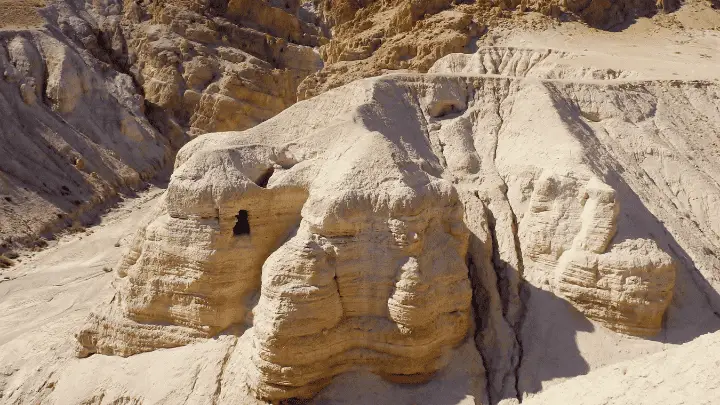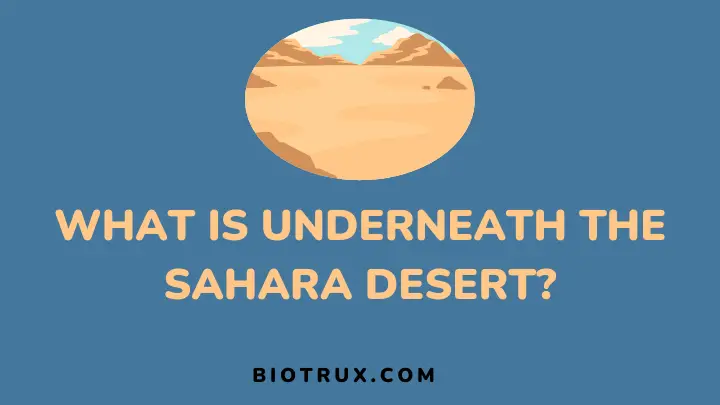When you picture the Sahara Desert, you might imagine vast stretches of sun-scorched dunes as far as the eye can see. But have you thought about what lies underneath the Sahara desert?
Brace yourself as you embark on an adventure to unravel the mysteries lurking underneath the surface of the Sahara. Digging deep into the sand reveals an intricate network of underground rivers, lakes, and vast aquifers.
These rivers provide a lifeline for desert inhabitants and remarkable ecosystems. It doesn’t end there; beneath the surface lie ancient cave systems with stalactites and stalagmites that look like something out of a storybook.
Join me as I peel back the layers and uncover the captivating secrets beneath the Sahara Desert. Prepare to be amazed; the desert’s secrets are as mesmerizing as the golden dunes adorn its surface.
Introducing the Sahara Desert

Welcome to the world of the Sahara Desert. Situated in North Africa, this breathtaking marvel captivates adventurers’ hearts worldwide. Imagine an immense stretch of sandy wonder spanning a mind-boggling 3.6 million square miles.
With scorching temperatures and endless dunes, the Sahara will leave you in awe. Behold the magic of sunrises and sunsets that paint the sky in vibrant hues. Imagine camel treks across this vast landscape or getting lost in the mesmerizing rock formations.
And oh, the night sky! Gaze upon a blanket of stars that will take your breath away—the Sahara Desert – a true marvel of nature.
Unveiling the Geological Mysteries of the Sahara Desert
The foundation: ancient bedrock and geological formation
The formation of the Sahara Desert is a tale of shifting landscapes and climatic changes. Millions of years ago, this region was lush and fertile, teeming with life.
However, over time, the Earth’s tectonic plates shifted, creating changes in the landscape and altering the climate. The Sahara’s foundation is ancient bedrock dating back millions of years, hidden under a sea of sand.
This geological formation, primarily consisting of granites, schists, and sandstones, provides the stable base upon which the desert’s shifting dunes rest.
Hidden aquifers: the lifeblood of desert oases
Contrary to popular belief, the Sahara has water. Scattered throughout the desert are vast aquifers, which are permeable rock layers containing water beneath the surface.
These aquifers serve as life-giving reservoirs, sustaining isolated oases and supporting flora and fauna uniquely adapted to the desert’s harsh conditions.
Exploring the Wonders Underneath the Sahara Desert
Fossil remnants: traces of ancient life
The Sahara’s secrets include remnants of a distant past. Fossilized evidence of prehistoric creatures, ancient plants, and even early human civilizations has been discovered beneath the arid sands.
These preserved relics offer valuable insights into the region’s evolution and the adaptations that enabled life to thrive against all odds. In fact, some of the fossils date back to the Paleozoic era, which was over 500 million years ago.
Exploring the Sahara’s fossil-rich areas is like taking a journey back in time, and it’s a must-visit destination for any adventurous traveler or history buff. But it’s not just the big and flashy fossils that make the Sahara a unique location for paleontologists.
Microscopic fossils, such as pollen and spores, provide insight into ancient plant life in this arid area.
Mineral treasures: riches from below
The Sahara desert appears barren, yet it is rich in valuable minerals waiting to be uncovered. From iron ore and phosphate deposits to precious metals like gold and copper, the Sahara holds hidden riches that have attracted explorers and mining ventures.
There’s a lot of oil and gas in countries like Algeria, Libya, Sudan, and Niger, which could help those places grow and help the world’s energy supply. Many industries benefit from abundant gold, copper, tin, and iron ore.
Furthermore, Morocco has a lot of phosphates, which are important for agriculture, and countries like Niger and Mauritania have found uranium, which is used in nuclear power.
Exploring the Hidden Trails Underneath the Sahara Desert

The role of faults in shaping the subsurface
Geological faults and fractures in the Earth’s crust play a significant role in shaping the subterranean landscape of the Sahara. These faults not only influence the movement of groundwater but also contribute to the formation of natural reservoirs, enhancing the desert’s geological diversity.
Unveiling caves and caverns
The Sahara’s depths are adorned with captivating caves and caverns, etched over millennia by the relentless forces of nature. These hidden wonders, formed over thousands of years, offer a cool and mysterious refuge from the relentless heat above.
These underground marvels hold secrets yet to be fully explored, created by the complex interplay of erosion, geology, and time. From stunning stalactites and stalagmites to vast chambers adorned with intricate limestone formations, the caves of the Sahara are a captivating sight.
They are a reminder that even in the harshest of environments, nature always finds a way to surprise and mesmerize us.
FAQs
Are there underground rivers beneath the Sahara?
Yes, beneath the Sahara’s surface, hidden rivers known as “wadis” flow. These wadis are intermittent watercourses that channel rainwater through the desert, providing a lifeline for various organisms and contributing to the formation of oases.
Can underground aquifers be tapped for freshwater?
Indeed, several countries in the Sahara region rely on tapping into underground aquifers to secure freshwater supplies. It is important to handle this practice cautiously to preserve these valuable reserves.
How do geological faults impact what lies beneath the Sahara Desert?
Geological faults, fractures in the Earth’s crust, play a significant role in shaping the Sahara’s subsurface. They influence the movement of groundwater, contribute to the formation of underground rivers, and impact the overall geology of the desert’s depths.
What is the biggest problem facing the Sahara Desert?
One of the biggest problems facing the Sahara Desert is the high temperature (usually above 40°C) and desertification. Desertification refers to the gradual expansion of arid land at the expense of fertile areas. Extreme temperatures, overgrazing, deforestation, and unsustainable land use practices drive this phenomenon.
Final Thoughts
As we conclude our journey through the depths of the Sahara Desert, one thing becomes abundantly clear: there is so much more to this vast desert than meets the eye. While many may imagine nothing but endless dunes, much more is going on below the surface.
It’s a reminder that a whole new world lies beneath the surface, brimming with life and unexpected wonders. Exploring what lies underneath the Sahara, we have witnessed the power of nature to carve out underground lakes, reservoirs, and breathtaking cave formations.
These underground reservoirs are essential for the region’s survival of both humans and wildlife. In addition, fossils found in these areas provide valuable insights into the history of our planet and how it has evolved.
The Sahara Desert is a testament to our planet’s beauty, complexity, and enduring spirit. Let it inspire you to explore, uncover, and embrace the hidden marvels surrounding us daily.
You can also learn more about the desert ecosystem in general.
Thanks for reading.

